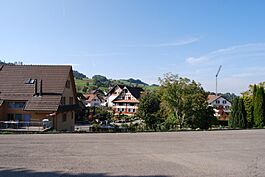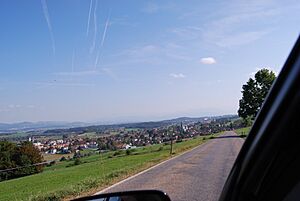Boswil facts for kids
Quick facts for kids
Boswil
|
||
|---|---|---|
 |
||
|
||
| Country | Switzerland | |
| Canton | Aargau | |
| District | Muri | |
| Area | ||
| • Total | 11.78 km2 (4.55 sq mi) | |
| Elevation | 456 m (1,496 ft) | |
| Population
(Dec 2020 )
|
||
| • Total | 2,923 | |
| • Density | 248.13/km2 (642.7/sq mi) | |
| Postal code |
5623
|
|
| Surrounded by | Aristau, Besenbüren, Bettwil, Bünzen, Buttwil, Kallern, Muri, Waltenschwil | |
Boswil is a small town, also called a municipality, located in the Muri district. It is part of the canton of Aargau in Switzerland. The village sits in the Bünztal valley, which is at the base of the Lindenberg mountain. The area also includes a small settlement called Wissenbach and a former farm estate named Sentenhof.
Contents
History of Boswil
Early Settlements
People first settled near the Bünzersee (a small lake) during the Neolithic period. This was a very long time ago, between 10,000 and 8,000 years before the Common Era (BCE). The lake was full of fish, which made it a good place to live.
In 1930, an old cemetery was found north of Boswil. It was from around 350 to 325 BCE. This discovery shows that Celtic people lived in the area during that time. You can also find remains of old farms and large houses from Roman times nearby.
First Mention and Rulers
Boswil was first written about in a document from the Grossmünster church in Zürich. The document called the village Bozuuila. Experts believe this document was written between 874 and 887 CE.
For many years, the Habsburg family ruled Boswil and the areas around it. But by 1379, they started to lose land to the growing Swiss Confederates. From 1380, the lords of Hallwyl took control of Boswil. Later, in 1483, it was given to the Muri Abbey, a type of monastery.
Divided Lands
In 1415, the eight original cantons of the Old Swiss Confederacy joined together. They took charge of all important matters for the region.
A big fire destroyed a third of Boswil in 1649. After a war in 1712, the lands known as the Freie Ämter were split into two parts. A new border line went right through Boswil. This meant the northern part of Boswil was controlled by Protestant cantons like Zürich and Bern. The southern part was controlled by Catholic cantons.
Because Boswil was split between two different rulers, it was hard for the village to grow. Even when the Helvetic Republic was formed in 1798, Boswil remained divided. It was split between the canton of Baden and the new canton of Aargau. Finally, in 1803, these two cantons joined to form the canton of Aargau. Since then, Boswil has been part of the Muri district.
Growth and Industry
Industrialization, meaning the growth of factories and industries, started in Boswil in 1874. This happened when the Aargauische Südbahn railway line opened, connecting Aarau to Muri and making Boswil a stop.
From 1870, people started digging for peat in the Bünzmoos swampland. Peat is a type of soil made of decayed plants, used as fuel. This swampland formed because the Bünzersee lake slowly filled up with dirt. In the 1930s and 1940s, many companies mined peat. They cleared a large area, over 2 square kilometers, digging down 6 meters deep. As more factories were built, Boswil grew into an industrial area.
Geography of Boswil
Boswil covers an area of about 11.77 square kilometers (4.54 square miles). A large part of this land, about 65.8%, is used for farming. Forests cover about 21.9% of the area.
Around 10.9% of the land is developed with buildings and roads. A small amount, 0.8%, is made up of rivers or lakes. The remaining 0.4% is land that cannot be used for farming or building.
Most of the forested land is covered with thick forests. For farming, nearly half of the land is used for growing crops. About 16.3% is used for pastures where animals graze. A small part, 1.2%, is used for orchards or vineyards. All the water in Boswil is found in its rivers and streams.
The town is located in the Muri district. It sits on the eastern side of the Lindenberg mountain, in the valley of the Bünz river. The municipality of Boswil includes the main village itself.
Coat of Arms
The official symbol, or blazon, of Boswil's coat of arms is a blue shield with a golden moon. This moon is shown as a crescent, meaning it's only partly visible, and it has a human face on it.
Population and People
Boswil has a population of around 2,990 people (as of 2023). About 12.9% of the people living in Boswil are from other countries. Over the past ten years (1997–2007), the population has grown by about 1.5%.
Most people in Boswil (92.2%) speak German. Italian is the second most common language (2.2%), followed by Albanian (1.4%).
Let's look at the age groups in Boswil (as of 2008):
- Children aged 0-9: 9.0%
- Teenagers aged 10-19: 12.0%
- Young adults aged 20-29: 15.2%
- Adults aged 30-39: 13.1%
- Adults aged 40-49: 17.5%
- Adults aged 50-59: 14.0%
- Seniors aged 60-69: 9.4%
- Seniors aged 70-79: 6.2%
- Seniors aged 80-89: 3.0%
- Seniors aged 90 and older: 0.6%
In 2000, the average number of people per living room was 0.55. This is similar to the average for the whole canton. A "room" here means a space in a home that is at least 4 square meters, like bedrooms, dining rooms, living rooms, and kitchens. About 53.6% of homes were owned by the people living in them.
In 2000, there were 882 private homes and apartments in Boswil. The average household had 2.5 people. In 2008, 38.5% of all homes were single-family houses. There were 70 empty apartments, meaning 6.8% of homes were available. In 2007, about 8.1 new homes were built for every 1000 residents.
In the 2007 federal election, the most popular political party was the SVP, which got 44.1% of the votes. The next most popular parties were the CVP (24.3%), the SP (10.6%), and the Green Party (7%).
Here's how the population of Boswil has changed over time:
| Historical population | ||
|---|---|---|
| Year | Pop. | ±% |
| 1765 | 709 | — |
| 1850 | 1,249 | +76.2% |
| 1900 | 1,246 | −0.2% |
| 1950 | 1,463 | +17.4% |
| 2000 | 2,308 | +57.8% |
How Boswil is Governed
Local Government
The laws in Boswil are made at municipality meetings, where local citizens can gather and make decisions. The local council is in charge of putting these laws into action. The council members serve for four years, and the people choose them. The council leads the town and carries out the decisions made at the municipality meetings.
The five local councillors are:
- Alois Huber
- Ruedi Return
- Othmar Stoeckli
- Roger Wiesli
- Elmar Mueller
Legal System
There are four levels of law in Switzerland. For Boswil, the district court of Muri handles local legal matters. A justice of the peace is a local official who helps solve minor disputes. Boswil shares a justice of the peace with several other nearby towns, including Besenbueren, Bettwil, Bünzen, Kallern, Rottenschwil, and Waltenschwil.
Important Historical Buildings
Several places in Boswil are considered important heritage sites. These are special places that are protected because of their history or cultural value. The Catholic church of St. Pankraz, the Säge Weissenbach (a sawmill) at Weissenbach 301, and House Nr. 169 on Niesenbergstrasse 6 are all listed as national heritage sites. The entire village of Boswil is also recognized as part of the Inventory of Swiss Heritage Sites.
The old parish church of St. Pankraz was built in the 1600s around an older, late-Gothic tower. In the 1700s, the church was redecorated inside and out. In 1913, the church was no longer used for religious services. Since 1953, it has been used as a concert hall, hosting many musical events.
Economy of Boswil
In 2007, the unemployment rate in Boswil was very low, at 1.21%. This means most people who wanted to work had jobs.
In 2005, there were 145 people working in the primary economic sector, which includes farming and forestry. There were 43 businesses in this area. The secondary sector, which involves manufacturing and construction, employed 334 people in 45 businesses. The tertiary sector, which includes services like shops and offices, employed 497 people in 77 businesses.
In 2000, 1,260 workers lived in Boswil. About 69.4% of these residents worked outside of Boswil, meaning they traveled to other towns for their jobs. However, 505 people traveled into Boswil for work. In total, there were 890 jobs in the municipality. Of the people who worked, 9.5% used public transportation to get to their jobs, and 52% drove their own cars.
Boswil has many industrial companies, especially in the construction and transportation industries. There are also several businesses that offer trade and services.
Transportation
The main road connecting Lenzburg and Luzern goes right through the middle of Boswil. This road is used for both private cars and public transport. The Swiss Federal Railways has a train station called Boswil-Bünzen. This station is on the railway line that connects Aarau and Arth-Goldau.
Schools in Boswil
Boswil has its own primary and secondary schools. For older students, the district school is located in Muri, and the Cantonal school is in Wohlen. Generally, people in Switzerland are well-educated. In Boswil, about 72.5% of adults (aged 25 to 64) have completed either a non-mandatory upper secondary education or a higher education degree from a university or a specialized college (Fachhochschule).
In the 2008/2009 school year, there were 147 students attending primary school in Boswil. There were also 126 students attending secondary school in the municipality.
Religion
According to the 2000 census, most people in Boswil are Roman Catholic, making up 69.7% of the population. Another 14.1% belonged to the Swiss Reformed Church (Protestant). A very small number of people belonged to the Christian Catholic faith.
Culture
In the late 1880s, a new church was built in Boswil and opened on August 24, 1890. The old church had become too small, so it was later sold along with the nearby parsonage building (the house where the church leader lived).
Since then, the old church has become a special place for cultural events, especially concerts. These events happen regularly and some have even gained worldwide attention. The old parsonage building was first used as a home for older artists. Later, it became a place for creative art classes.
See also
 In Spanish: Boswil para niños
In Spanish: Boswil para niños






